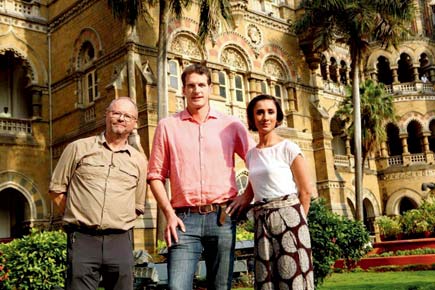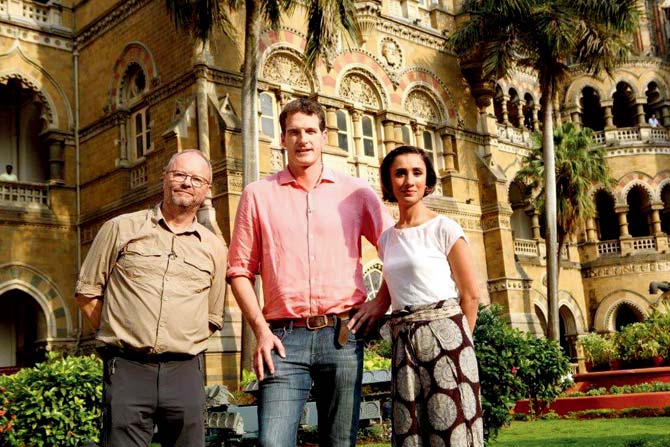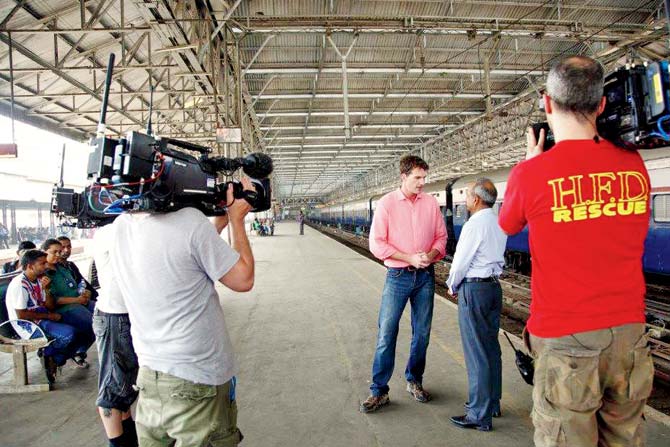Presenter of BBC show Mumbai Railway, currently streaming on Netflix, gushes about the magnificently efficient crew that runs the world’s busiest railway


Presenters Robert Llewellyn, Anita Rani and Dan Snow
ADVERTISEMENT
After shooting at CST, I have changed my mind about India being chaotic. The new railway terminus is the most modern and efficient I’ve ever been on,” says Dan Snow, presenter of the BBC show Mumbai Railway that is now streaming on NetFlix. The show has hosts Dan Snow, Anita Rani, Robert Llewellyn and John Sergeant exploring the world’s busiest railway. From Chhatrapati Shivaji Terminus, they try and delve into the science, systems and staff that keep this machinery running. The show, which had been in the works from September 2014, released in August last year on BBC2, and this year on Netflix India. “We have made a number of ‘live’ shows about the logistics around complicated operations. So, we were discussing doing a live series from a big rail terminal in London, and then the discussion moved on to featuring a rail network abroad. We looked at Mumbai alongside a number of other cities, but I think the lure of India, the British connection, the site of that magnificent building (designed by a British architect), and the incredible feat that is achieved each day by the team at CST, bringing millions of Mumbaikars into and out of the city by train – well, it was just a winner,” executive producer Lisa Ausden told us over email.
Busiest railway
The presenters and makers couldn’t get enough of the fact that it was the “busiest railway system in the world”, as Snow says, and this often leads them to remarking about how extraordinary the ordinary Indian is, doing this day in and day out. Shooting also presented certain challenges that the British crew had to work around. “Health and safety was quite a big issue. A lot of the vantage points at CST were on top of buildings, and trains themselves are big, moving objects. One of the presenters spent time with the repair teams on the live lines one weekend, and the system does not close down for this work. It’s potentially dangerous, and you have to watch carefully for the next passing train!” says Ausden.
Dabbawalas
And, like so many others, apart from the railway system, what truly caught their fancy was the dying breed of dabbawalas. “I think the dabbawala system was pretty mind-blowing – for us, as programme makers, and for the British audience. It’s such a big cultural difference between India and the UK. It’s a tried, tested, ingenious system which has remarkably few failures… we all lead such busy lives, but seeing office workers getting healthy, home cooked food in their offices every day, delivered by a man on a bicycle… we admired it and marvelled at it.”

Behind the scenes shot on the sets Mumbai Railway
Future perfect
Right now, they are excited at the thought of Indian audiences watching the show. “I hope Indians take pride in an extraordinary railway network and a sense of excitement about what the future holds,” says Snow, while Ausden adds, “I hope viewers take away an appreciation of what the teams at CST, and out in the suburbs, are doing every day. It’s a system operating at its limit… a train breaks down, or an incident happens — these people have to find a way around it, to keep the system moving. It’s not perfect, but it’s the beating heart of Mumbai. I think you can appreciate this if you are in the UK, and if you are one of the people using the trains every day. Behind the scenes, getting privileged access, is a window on a world we mostly take for granted. It was an extraordinary experience.”
 Subscribe today by clicking the link and stay updated with the latest news!" Click here!
Subscribe today by clicking the link and stay updated with the latest news!" Click here!






